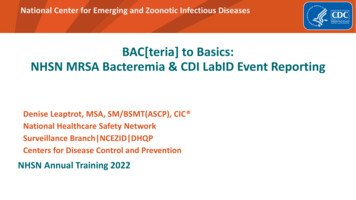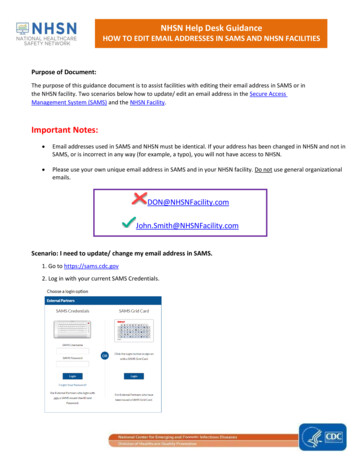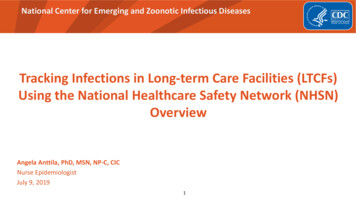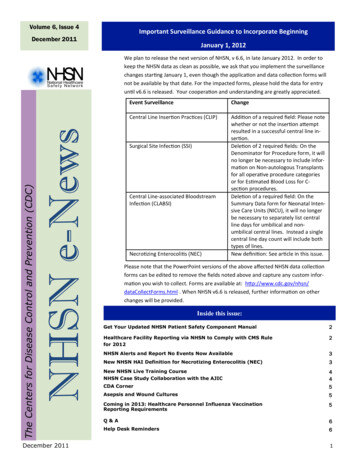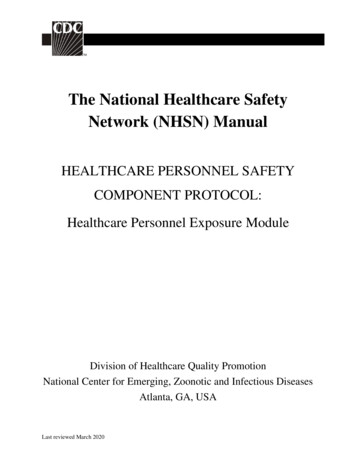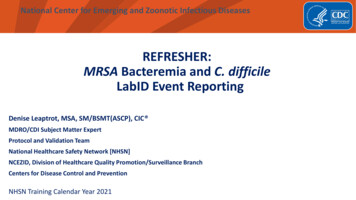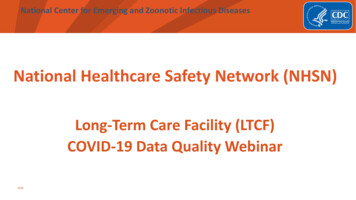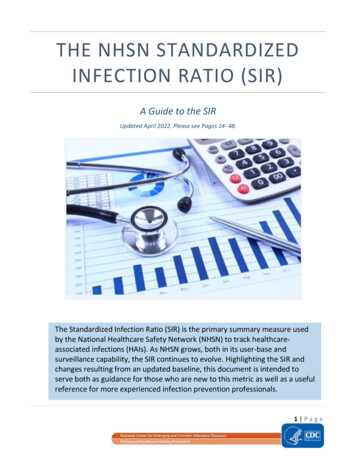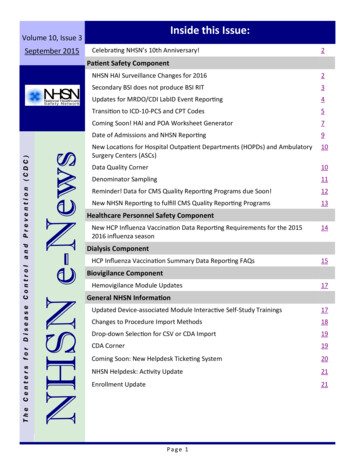
Transcription
Inside this Issue:Volume 10, Issue 3September 2015Celebrating NHSN’s 10th Anniversary!2NHSN e-NewsThe Centers for Disease Control and Prevention (CDC)Patient Safety ComponentNHSN HAI Surveillance Changes for 20162Secondary BSI does not produce BSI RIT3Updates for MRDO/CDI LabID Event Reporting4Transition to ICD-10-PCS and CPT Codes5Coming Soon! HAI and POA Worksheet Generator7Date of Admissions and NHSN Reporting9New Locations for Hospital Outpatient Departments (HOPDs) and AmbulatorySurgery Centers (ASCs)10Data Quality Corner10Denominator Sampling11Reminder! Data for CMS Quality Reporting Programs due Soon!12New NHSN Reporting to fulfill CMS Quality Reporting Programs13Healthcare Personnel Safety ComponentNew HCP Influenza Vaccination Data Reporting Requirements for the 20152016 influenza season14Dialysis ComponentHCP Influenza Vaccination Summary Data Reporting FAQs15Biovigilance ComponentHemovigilance Module Updates17General NHSN InformationUpdated Device-associated Module Interactive Self-Study Trainings17Changes to Procedure Import Methods18Drop-down Selection for CSV or CDA Import19CDA Corner19Coming Soon: New Helpdesk Ticketing System20NHSN Helpdesk: Activity Update21Enrollment Update21Page 1
Celebrating NHSN’s 10th Anniversary!NHSN has reached an important milestone. October 2015 marks the system’s 10th year of operations and caps adecade of remarkable growth: From approximately 300 hospitals and fewer than 500 individual users participating inNHSN when it was launched in October 2005 to over 16,000 healthcare facilities and more than 40,000 individual userstoday. NHSN has established itself as a trusted platform for multiple users and uses and serves as a vital resource forsurveillance and prevention at the local, state, and national levels. CDC’s NHSN team is deeply grateful for theenormous contribution of 1000’s of system users to NHSN’s successes, most importantly, the benefits theirparticipation in the system have provided for patient safety and public health. NHSN’s individual users are themainstays of the system and the catalysts for change at the frontlines of healthcare. NHSN staff also are grateful forthe vitally important partnerships that have been forged with state and local health departments, consumer groups,professional societies, prevention collaboratives, academic organizations, hospital and other healthcare associations,information technology companies, data standards organizations, and federal colleagues working in other agencies,including leadership and program staff at the Centers for Medicare and Medicaid Services. These partnerships havebeen instrumental in NHSN’s evolution and expanding role. NHSN’s first decade also has been accompanied bygrowing pains, among them occasional communications mishaps and operational snarls or delays. The NHSN team hasdone its utmost to remedy these shortcomings as quickly as possible and uses each problem and response as a lessonlearned for the future. This milestone is an opportunity for all of us to take stock of the experience we have gained increating, using, and improving NHSN. Much has been accomplished and learned in the system’s first decade, and withpast as prologue even more can be achieved in the next 10 years. Happy 10th anniversary NHSN!Patient Safety ComponentNHSN HAI Surveillance Changes for 2016Surveillance protocols for NHSN Patient Safety Component participation are in the final stages of updating for 2016.Some operational details have yet to be finalized, but NHSN is targeting a publication date of November 1, 2015 so thatfacilities can prepare for applying the changes January 1, 2016.While specifics and final decisions are not yet available, information can be shared on topics under discussion, whichinclude and address: Positive blood cultures associated with observed or suspected patient access of vascular access lines that isdocumented in the medical recordThe use of non-culture diagnostic test results in place of culture results for NHSN HAI surveillanceThe classification of infections with community-associated fungal pathogens as HAIsPositive cultures collected from patients declared brain dead and awaiting organ harvesting for donationSymptoms of infection at non-central line vascular access sites with concurrent positive blood culturesRespiratory specimen types used for PNU3 criteriaBSIs reported with enteric organisms such as SalmonellaIntraabdominal infections (IAB) without culture or imaging test, and positive blood culture with intestinalorganismNHSN will highlight and communicate any related changes in surveillance before the protocols go into effect.Page 2
Secondary BSI does NOT produce BSI RITSome NHSN users have communicated a misunderstanding of the concept of Repeat Infection Timeframe (RIT). Thismisunderstanding occurs most often when performing Central Line-associated Bloodstream Infection (CLABSI)surveillance. RITs are only set when an infection criterion is met, and they are specific to the type of infection identifiedand do not affect reporting of other types of infections. BSIs that are secondary to another primary site of infection donot meet the NHSN Laboratory Confirmed Bloodstream Infection (LCBI) criteria. Therefore, a secondary BSI to primarysite of infection does not have an RIT of its own that captures all subsequent positive blood cultures.Let’s consider an example:In a case where a non-surgical intra-abdominal infection (IAB) meets criteria, and a BSI is identified as secondary to thatIAB, an IAB RIT would be set. During that RIT, no other IABs would be reported to NHSN. However, a BSI RIT wouldNOT be set. LCBI criteria are not satisfied when a BSI is secondary to another site of infection, therefore no LCBI (BSI)RIT is created. Any BSIs that occur during the IAB RIT would need to be considered as a potential NHSN primary BSI andincluded in any BSI surveillance performed in that location. If the BSI has at least one matching pathogen to the sitespecific culture or the blood culture used to originally meet the IAB definition or if the blood culture can be used tomeet the IAB definition during the IAB RIT, the BSI would be considered secondary to the IAB. If none of thesescenarios are true, and if the BSI cannot be determined to be secondary to a different primary site of infection, the BSIwould be considered an NHSN primary BSI.Secondary BSI does NOT produce BSI RIT example continued on page 4Page 3
BSI Secondary does NOT produce BSI RIT (continued)Likewise, if a BSI is identified according to the NHSN surveillance protocols to be present on admission (POA), it isnecessary to determine if the BSI is a primary BSI or secondary to another primary site of infection. If determined to bea primary BSI, then an LCBI RIT will be created and no new BSIs will be reported with a date of event occurring duringthe POA BSI RIT. If the POA BSI was determined to be secondary to another primary site of infection, then no BSI RITwould be created and any subsequent positive blood cultures would need to be considered as a potential NHSNprimary BSI as described above.Updates for MDRO/CDI LabID Event ReportingNew: 2015 “optional” questions will change to “required” for 2016 - Laboratory-identified MDRO or CDI Event form(CDC 57.128)The following “optional” questions will be “required” starting January 1, 2016: Last physical overnight location of patient immediately prior to arrival into facility (question available for LabIDEvents if the specimen is CO, i.e., collected from an outpatient setting or collected 4 days after admission). Has patient been discharged from another facility in past 4 weeks? If yes, from where (check all that apply). Thefollowing value set will populate for selection: nursing home/skilled nursing facility; other inpatient healthcaresetting (i.e., acute care hospital, IRF, LTAC, etc.).This required information will be used to improve tracking through the continuum of care for patients and to betteralign categorization of CO-HCFA (community onset- healthcare facility associated) CDI LabID events.Updates for MDRO/CDI LabID Event Reporting continued on page 5Page 4
Updates for MDRO/CDI LabID Event Reporting (continued)NEW Data Entry Fields for Facilities Reporting CRE LabID EventsAs shown in the below excerpt from the MDRO module’s Tables of Instruction for LabID Events, two questions relatedto CRE testing will populate when submitting a CRE LabID event:Tested forcarbapenemase?Positive forcarbapenemase?Conditionally Required. If the specific organism type is CRE, select “Yes” if thebacterial isolate was tested for carbapenemase. Otherwise, select “No” or“Unknown”. If “Yes”, select which test(s) was performed (may select more thanone tests). Users may need to seek additional guidance from the facility laboratory to answer this question.Conditionally Required. If the bacterial isolate was tested for carbapenemase,select “Yes” if the isolate tested positive for carbapenemase. Otherwise, select“No” or “Unknown”.Transition to ICD-10-PCS and CPT CodesAfter the initial release (8/28/15) of the NHSN Operative Procedure Code category excel documents, one for CPT codesand one for ICD-10-PCS codes, necessary modifications were identified. An email was sent out to all NSHN users earlierthis week regarding these updates. The updated documents can be found in links provided further in the article.Codes for the following procedure categories have been updated:ICD-10-PCS:AAA; BRST; CARD; COLO; CRAN; FUSN; GAST; HYST; KPRO; OVRY; REC; SB; SPLE; THOR; THYR; VHYS; VSHN; XLAPCPT:APPY; BILI; CARD; CBGB; CRAN; GAST; HER; LAM; NEPH; OVRY; PVBY; PRST; REC; SB; THYR; VSHN; XLAPNHSN has uploaded two new supplemental mappings to the NHSN website in the “Supporting Materials” section of theSSI page for both Acute Care Facilities and Ambulatory Surgery Centers. These documents are available for mapping“ICD-10-CM Diabetes Diagnostic Codes” and the “ICD-10-CM/PCS code for prior infection at hip or knee jointdenominator form question” for the “If total or partial revision, was the revision associated with prior infection ofindex joint?” question on the denominator procedure entry.All of the mappings can be found in the links urgery/ssi/index.htmlNHSN will provide additional supplemental mapping guides for the following as soon as they are available: Mapping guidance for the detail fields for HPRO and KRPO (e.g., Total Primary versus Total Revision) Mapping guidance for detail fields for FUSN for spinal level and approachTransition to ICD-10-PCS and CPT Codes continued on page 6Page 5
Transition to ICD-10-PCS and CPT Codes (continued)ICD-10-PCS codes will replace ICD-9-CM codes on October 1, 2015, however NHSN will not have the ability to receivethese codes until the January 2016 NHSN release. Beginning October 1, 2015 and continuing until the January 2016NHSN release, when entering surgical procedure (denominator) data into NHSN for SSI surveillance, facilities shouldenter the NHSN Procedure Code (e.g. COLO or HYST) as identified in the new mappings provided, but the applicationcannot accept ICD-10-PCS/CPT codes associated with the procedure until the release of the 2016 application in January2016. This includes data that is entered manually, electronically downloaded, or imported via a comma-separatedvalue (CSV) file. The NHSN application can accept ICD-9-PCS codes for all of 2015 if the facility has access to them.Once the NHSN release takes place in 2016, facilities will once again be able to choose to enter the NHSN OperativeProcedure Code category or instead enter one of the ICD-10-PCS or CPT codes, and have NHSN auto-populate theNHSN Operative Procedure Code category.Please note that: ICD-10-PCS and CPT code fields will remain as optional fields in 2016. ICD-10-PCS and CPT codes do not differentiate between spinal fusions (FUSN) and repeat spinal fusions(RFUSN). Therefore, the NHSN procedure group FUSN will include both fusion and re-fusion procedures,and the RFUSN category should not be used for procedures performed on or after October 1, 2015. Requirements to map the current NHSN operative procedure code category “OTH-Other” to ICD-10-PCSand CPT codes exceeded available NHSN resources. “OTH – Other” is a default category for NHSN operativeprocedures which do not fall into one of the 39 NHSN Operative Procedure Code categories, and for whichNHSN does not provide any benchmarking data. For these reasons, the NHSN Category “OTH” will not bemapped to ICD-10-PCS and CPT codes and will not be available for use in 2016. Any infections associatedwith procedures in that group will not be considered an NHSN surgical site infection, beginning withOctober 1, 2015 procedures.For questions related to: Selecting ICD-10 codes for NHSN SSI Surveillance: contact us at NHSN@cdc.gov. Clinical data architecture (CDA) or upload of operative procedure data from an infection control softwareprogram: contact us at NHSNCDA@cdc.gov. Electronic import of operative procedure data via comma separated values (csv) files- information will beposted in the next few weeks and a blast email notification will be sent out at that time.Page 6
Healthcare-associated Infection (HAI) and Present on Admission (POA)Worksheet GeneratorComing soon!! You asked and we listened!NHSN plans to release a Healthcare –associated Infection (HAI) and Present on Admission Infection (POA) WorksheetGenerator that will be available for use with multiple site specific infection types (e.g., BSI, UTI, PNEU, IAB etc.). TheWorksheet Generator will operate based upon the currently posted guidance found in the Patient Safety ComponentManual, Chapter 2, Identifying Healthcare-associated Infections (HAI) for NHSN Surveillance. The Worksheet Generatorwill be a web-based tool that is designed to identify the: 7-day Infection Window Period Date of Event and POA or HAI determination 14-day Repeat Infection Timeframe (RIT) Secondary Bloodstream Infection Attribution PeriodIt is important to note that the Worksheet Generator will not function as a calculator. It will not determine if NHSNinfection criteria have been met, that is incumbent upon the user. The Worksheet Generator requires the user to enterthe date of admission, the date of the first diagnostic test (sign or symptom in the absence of a diagnostic test) used tomeet the NHSN site specific infection criterion and all additional date(s) representative of the required elementsneeded to satisfy an NHSN site specific infection criterion.Based upon this information provided by the user, the Worksheet Generator will electronically generate a printableworksheet that identifies the date of event and determines if the event is POA or HAI. In addition, the WorksheetGenerator will define the Infection Window Period, Repeat Infection Timeframe (RIT), and when appropriate theSecondary BSI Attribution Period. The Worksheet Generator will not store any patient data that you enter, and it willnot report any data that you enter or anydeterminations made to the NHSN application.The Worksheet Generator will allow free textin some data fields and will also allow you toprint the final worksheet for surveillancepurposes. The results are accurate only if aninfection criterion was met as reflected in thedata supplied by the user.When available on the NHSN website, userswill be notified via Email of the location toaccess the Worksheet Generator. Note, theVAE calculator and MDRO & CDI LabID Eventcalculator will continue to be available for usewhen conducting VAE or MDRO/LabID eventsurveillance. The Worksheet Generator is notintended for use when conducting SSIsurveillance.Worksheet Generator continued on page 8Page 7
Healthcare-associated Infection (HAI) and Present on Admission (POA)Worksheet Generator (continued)Page 8
Healthcare-associated Infection (HAI) and Present on Admission (POA)Worksheet Generator (continued)Correct Date of Admission is Vital to Accurate NHSN ReportingMaking correct determinations about healthcare-associated infection (HAI) surveillance is important for many reasons,including ensuring that HAI data is useful for evaluating the success of HAI prevention efforts, ensuring the data isappropriate for use in The Centers for Medicare and Medicaid Services (CMS) quality reporting programs, and to avoiddisagreements with the findings from CMS HAI data audits.Within NHSN, the date of admission is used to determine if infections are health-care associated, present on admission,community onset, or healthcare-facility onset (depending on the module[s] of participation). The date of admission isdefined as the date that the patient is physically admitted to an inpatient location. It is not the date that the patient’sadmission order is written. For example, a patient’s admission order is written on Monday, but the patient does notmove into the inpatient location until Tuesday. The admission date is Tuesday for NHSN surveillance purposes.If your facility is using electronically collected data to determine the admission date, perhaps from an admission/discharge/transfer (ADT) system, it is recommended that the process be reviewed to be sure it is being accuratelydetermined. Likewise, if your facility is using an infection control software to collect data and determine date ofadmission, you should check to make sure that this is being done accurately. NHSN has received reports that someinfection control software systems may not be correctly identifying admission dates. This can negatively impact theaccuracy of your HAI data reported to NHSN.Page 9
New Locations for Hospital Outpatient Departments (HOPDs) and AmbulatorySurgery Centers (ASCs)The January 2016 release of NHSN will include new locations for defining an outpatient procedure room/suite (i.e.,HOPD) for use by acute care hospitals reporting to NHSN. Such units can be physically attached or detached from theacute care hospital, but should share a CMS Certification Number (CCN) with the acute care hospital. As such, datafrom these units should continue to be reported with the acute care hospital’s data, as appropriate. For those acutecare hospitals that have a location mapped in NHSN to the CDC Location “Ambulatory SurgeryCenter” (OUT:ACUTE:OR), and that have been using this location to report data, note that this CDC location will beretired beginning with the January 2016 release. At that time hospitals will be instructed to use the new CDC“Outpatient Procedure Room/Suite” locations for applicable reporting.Please note that only ambulatory surgery centers that have a CCN identifying the facility as an Ambulatory SurgeryCenter per CMS definitions, should be reporting to NHSN as an Ambulatory Surgery Center (AMB-SURG). Thesefacilities should not be reporting to NHSN as a location within an acute care hospital. In the January 2016 release ofNHSN, new location codes will be available and ASCs may notice a change in the CDC location code assigned to theirexisting ASC location(s), however no action will be required on the part of the ASC.The “CDC Location Labels and Location Descriptions” chapter of the NHSN Patient Safety Manual will be updated toinclude definitions for the new and updated locations.Data Quality CornerThe NHSN team continues our efforts to ensure the highest level of data quality in NHSN for the purposes of nationalbenchmarks, future risk-adjustment and national analyses, and for other uses of NHSN data by our partners (e.g., statehealth departments). This past quarter some facilities received electronic communications from the NHSN teamregarding potential data quality issues, including: LabID Event Reporting: Acute Care Hospitals (ACH) with 0 FacWideIN patient days AND 0 FacWideINadmissions for Jan, Feb, and/or March 2015LTACHs, ACHs and Free-standing Rehab facilities (IRFs) entering the exact same value for patient days andadmissionsRehab wards (located within an ACH) with extremely high patient daysThese data quality issues will impact the calculation of an acute care facility’s Standardized Infection Ratio (SIR), thusimpacting facility data posted on Hospital Compare. In addition, the 2015 data entered in NHSN will be used as thenew national baselines for future SIRs for all facilities (including LTACHs and IRFs) in the nation. We need your help toensure the new SIR baselines incorporate the most accurate data from all participating facilities. This quarter, theNHSN Team will continue to monitor the quality of data being entered. This may result in your facility being contactedwith outreach to help resolve any potential data quality problems. Thank you for your support and cooperation inmaintaining the quality and integrity of data reported in NHSN.Page 10
Denominator SamplingIn January 2015, NHSN introduced an alternative method for collecting NHSN CLABSI and CAUTI denominator data foruse in eligible ICU and ward location types. To ensure the accuracy of the estimated denominator data, only ICU andward location types with 75 or more device-days per month are eligible to use this alternative method. The traditionalmethod (counting every day of a month) for CLABSI and CAUTI denominators remains available for all NHSN users.During an internal analysis at CDC, we identified a number of hospitals that are using the Sampling denominatormethods in locations that are not eligible.To ensure the accuracy of estimated denominator data obtained by sampling, only ICU and ward location types with anaverage of 75 or more device-days per month are eligible to use this method. A review of each location’s device-daysdenominator data for the past 12 months in NHSN will determine which locations are eligible.Average number of device days per month Total number of device days (numcldays) / number of monthsPage 11
Reminder! Data for CMS Quality Reporting Programs due Soon!The following data must be entered into NHSN by November 15, 2015 for facilities that participate in certain CMSquality reporting programs.Acute Care Hospitals that participate in the Hospital Inpatient Quality Reporting (IQR) Program:2015 Quarter 2 (April 1 – June 30) CLABSI and CAUTI data All ICU locations Adult and pediatric medical, surgical, and medical/surgical wards2015 Quarter 2 (April 1 – June 30) Inpatient COLO and HYST SSI data2015 Quarter 2 (April 1 – June 30) MRSA Bacteremia and C. difficile LabID Events (all healthcare onset and communityonset) FacWideIN ED, and 24-hour observation locationsCancer Hospitals that participate in the PPS-Exempt Cancer Hospital Quality Reporting Program:2015 Quarter 2 (April 1 – June 30) CLABSI and CAUTI data (all bedded inpatient care locations)2015 Quarter 2 (April 1 – June 30) Inpatient COLO and HYST SSI dataInpatient Rehabilitation Facilities (IRFs) that participate in the Inpatient Rehabilitation Facility Quality ReportingProgram:2015 Quarter 2 (April 1 – June 30) CAUTI data (all bedded inpatient locations)2015 Quarter 2 (April 1 – June 30) MRSA Bacteremia and C. difficile LabID Events (all healthcare onset and communityonset) Freestanding IRFs: Reporting by FacWideIN IRF Units within acute care or critical access hospital: Reporting by each CMS IRF UnitLong-Term Acute Care Facilities (LTACs/LTCHs) that participate in the Long-Term Care Hospital Quality ReportingProgram:2015 Quarter 3 (July 1 – September 30) CLABSI and CAUTI data (all bedded inpatient locations)2015 Quarter 3 (July 1 – September 30) MRSA Bacteremia and C. difficile LabID Events (FacWideIN, all healthcare onsetand community onset)Please make sure at least one individual at your facility can access NHSN via SAMS and has been assigned appropriateuser rights in NHSN so they may enter and view the facility’s data. To ensure your data have been correctly enteredinto NHSN, please make sure to verify that: 1) your monthly reporting plans are complete, 2) you've enteredappropriate summary and event data or checked the appropriate no events boxes, and 3) you've cleared all alerts fromyour NHSN facility homepage. For additional guidance on ensuring your data are accurately sent to CMS for QualityReporting purposes, please visit our website and navigate to the appropriate section(s) for your facility type: http://www.cdc.gov/nhsn/cms/index.htmlIf you have any questions, please contact the NHSN Helpdesk: NHSN@cdc.gov.Page 12
New NHSN Reporting to fulfill CMS Quality Reporting ProgramsCMS has recently finalized requirements for their quality reporting programs. Below is a list of the recently finalizedrequirements along with previously finalized requirements for reporting in NHSN that will be going into effect on eitherOctober 1, 2015 (for the 2015-2016 influenza season) or January 1, 2016.Acute Care Hospitals that participate in the CMS Hospital Inpatient Quality Reporting (IQR) Program:There are no additions to the NHSN reporting requirements for Acute Care Hospitals for 2016.Cancer Hospitals that participate in the CMS PPS-Exempt Cancer Hospital Quality Reporting Program:Beginning January 1, 2016, Cancer Hospitals participating in the CMS PPS-Exempt QRP should begin reporting MRSABacteremia and C. difficile LabID Events by location at the facility-wide inpatient level (FacWideIN). The NHSN MDROProtocol, training materials, and data collection forms can be found here: rsa/index.html.Inpatient Rehabilitation Facilities (IRFs) that participate in the CMS IRF Quality Reporting Program:There are no additions to the NHSN reporting requirements for IRFs for 2016.Long-Term Acute Care Facilities (LTACs/LTCHs) that participate in the CMS LTCH Quality Reporting Program:Beginning January 1, 2016, LTACs participating in the CMS LTCH QRP should begin reporting Ventilator-AssociatedEvents (VAE) by location for all adult inpatient bedded locations. The NHSN VAE Protocol, training materials, and datacollection forms can be found here: http://www.cdc.gov/nhsn/ltach/vae/index.html.Also beginning January 1, 2016, the CMS reporting deadline for LTAC NHSN data will be extended to 4.5 months afterthe end of the reporting quarter. Below are the new reporting deadlines that will be used for 2016 moving forward:Quarter 1 (January – March): August 15Quarter 2 (April – June): November 15Quarter 3 (July – September): February 15Quarter 4 (October – December): May 15IMPORTANT NOTE: Quarter 3 (July – September) 2015 data will still be due into NHSN by November 15, 2015. Quarter4 (October – December) 2015 data will be due into NHSN by May 15, 2016.Ambulatory Surgery Centers (ASCs) that participate in the CMS ASC Quality Reporting Program:There are no additions to the NHSN reporting requirements for ASCs for 2016.Inpatient Psychiatric Facilities (IPFs) that participate in the CMS IPF Quality Reporting Program:Beginning with this 2015-2016 influenza season, IPFs should begin reporting healthcare worker influenza vaccinationsummary data. The reporting period for this new requirement is October 1, 2015 – March 31, 2016. For moreinformation on training materials please see the article “New HCP Influenza Vaccination Data Reporting Requirementsfor the 2015-2016 influenza season” on page 14 of the newsletter.New NHSN Reporting to fulfill CMS Quality Reporting Programs continued on page 14Page 13
New NHSN Reporting to fulfill CMS Quality Reporting Programs (continued)Dialysis Facilities that participate in the CMS End Stage Renal Disease (ESRD) Quality Incentives Program (QIP)Beginning with this 2015-2016 influenza season, Dialysis facilities should begin reporting healthcare worker influenzavaccination summary data. The reporting period for this new requirement is October 1, 2015 – March 31, 2016. Formore information on training materials please see the article “New HCP Influenza Vaccination Data ReportingRequirements for the 2015-2016 influenza season” below.The complete list of CMS reporting requirements and due dates can be found here: Reporting Requirements and Deadlines in NHSN per CMS Current ng-Requirements-Deadlines.pdf. Healthcare Facility HAI Reporting Requirements to CMS via NHSN - Current and Proposed Requirements: uirements.pdf.Healthcare Personnel Safety ComponentNew HCP Influenza Vaccination Data Reporting Requirements for the 2015-2016Influenza SeasonInpatient Psychiatric FacilitiesBeginning with the 2015-2016 influenza season, inpatient psychiatric facilities and units participating in the CMSInpatient Psychiatric Facility Quality Reporting (IPFQR) Program must submit HCP influenza vaccination summary datathrough NHSN. Inpatient psychiatric facility units that participate in the IPFQR Program and are located within acutecare hospitals must report data separately from their affiliated acute care hospital. Inpatient psychiatric facility trainingmaterials are located at: l.Outpatient Dialysis FacilitiesOutpatient renal dialysis facilities participating in CMS’s End-Stage Renal Disease (ESRD) Quality Incentive Program(QIP) will also be required to submit HCP influenza vaccination summary data through NHSN. This requirement appliesto outpatient dialysis facilities whether they provide in-center hemodialysis, peritoneal dialysis, or home hemodialysisservices. Outpatient renal dialysis facility training materials are located at: dex.html.Acute Care Facilities, Ambulatory Surgery Centers, Inpatient Rehabilitation Facilities, and Long Term Care HospitalsAs a reminder, acute care facilities, ambulatory surgery centers, inpatient rehabilitation facilities, and long term carehospitals that are required to report HCP influenza vaccination summary data to meet CMS reporting requirementsmust continue to do so for the 2015-2016 influenza season.
NHSN has reached an important milestone. October 2015 marks the system's 10th year of operations and caps a decade of remarkable growth: From approximately 300 hospitals and fewer than 500 individual users participating in NHSN when it was launched in October 2005 to over 16,000 healthcare facilities and more than 40,000 individual users today.
